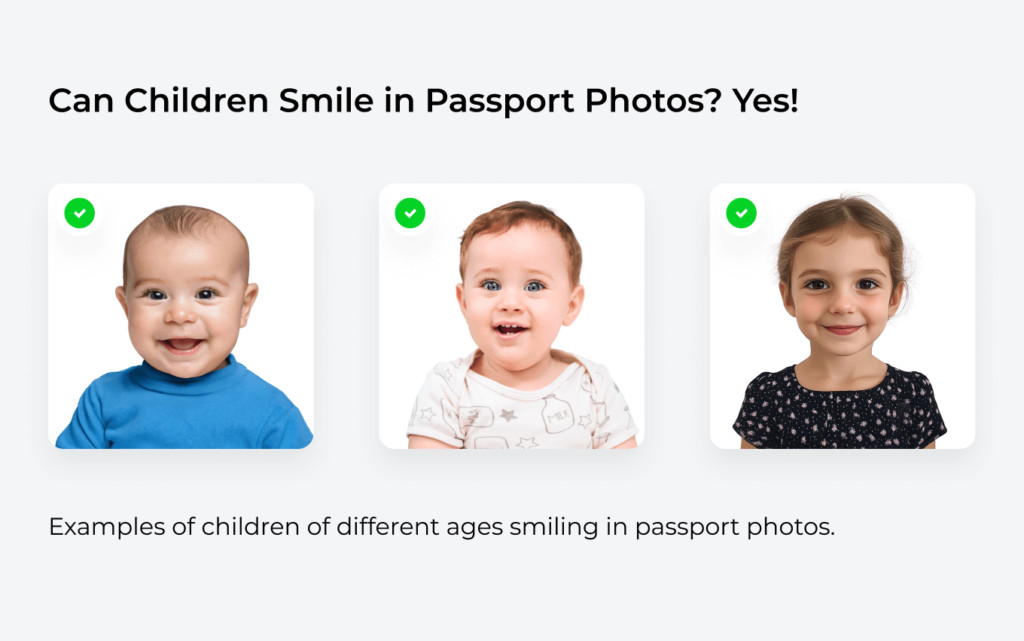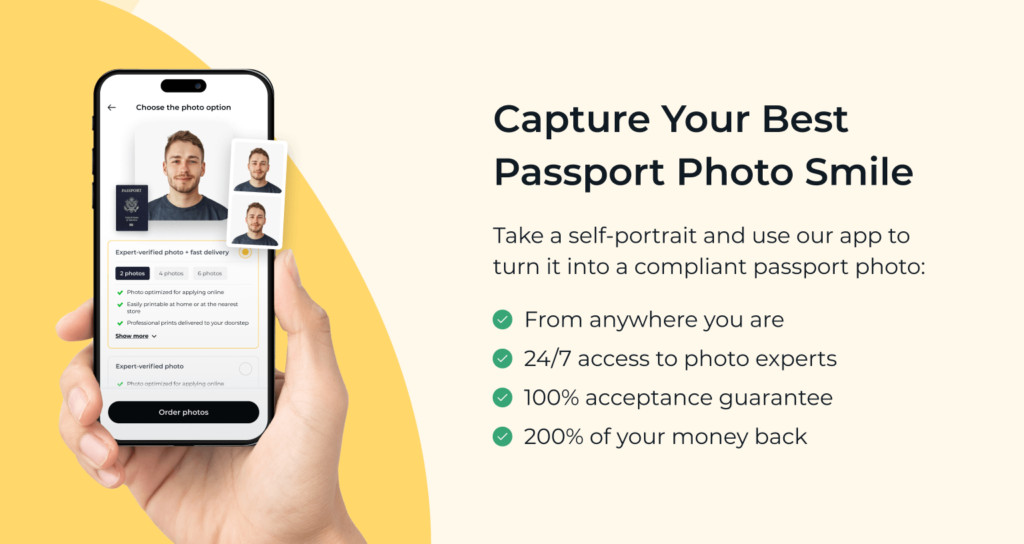Smiling in photos often feels natural, but passport photos come with specific guidelines. You might wonder, “Can I show my teeth when I smile for my passport photo?” It’s a common question, and understanding the nuances can save you from application delays.
Let’s explore the rules surrounding smiles in passport photos and clarify what’s acceptable to ensure your application process is smooth.
 A person happily holding their passport.
A person happily holding their passport.
 A close-up of passport photo specifications and online application process.
A close-up of passport photo specifications and online application process.
Get your perfect digital passport photo or printed copies quickly and easily with PhotoAiD®. We guarantee 100% acceptance, with expert verification for every photo. Enjoy a 2x money-back guarantee for peace of mind, all in just 3 minutes, trusted by over 11,000,000 happy users.
PhotoAiD was a lifesaver! I needed a passport photo urgently and their service was incredibly fast and easy. Taking a selfie and uploading it was all it took to get a compliant photo almost instantly. Even taking a photo of my baby was simple!
John
Excellent reviews on Trustpilot: 7,022 reviews.
The “No Teeth” Rule in Passport Photos: Why It Matters
The question isn’t strictly “Can you smile?”, but rather, “Can you show teeth in a passport photo?”. The primary reason behind the guidelines is facial recognition technology. Smiling broadly, especially showing teeth, can alter your facial features enough to interfere with the accuracy of these systems. While a slight smile is often permissible, showing teeth is generally discouraged or not allowed.
Denis Chagnon, a spokesman for the International Civil Aviation Organization (ICAO), elaborated on this in a CBS News interview concerning passport photo smile regulations. He explained that smiling or squinting reduces the distinct facial points needed for reliable biometric identification. Essentially, when your passport is scanned, the system needs clear, consistent reference points to verify your identity.
This means that while a natural expression is preferred, extreme smiles can hinder the facial recognition process at border crossings and other checkpoints.
💡 Did you know? While US guidelines are relatively lenient, allowing for a slight smile, many countries, particularly in Europe like the UK, enforce a stricter neutral expression rule. In many European countries, smiling is completely banned in passport photos, requiring a completely neutral, almost “mugshot-like” expression.
Acceptable Smiles vs. Smiles to Avoid in Passport Photos
Based on an internal study analyzing over 10,000 ID photos and common rejection reasons, incorrect facial expressions, including inappropriate smiles, rank as the third most frequent mistake. Understanding the acceptable range of smiles is crucial for passport photo compliance.
So, to what degree can you smile in your passport photo?
- Acceptable Smile: A subtle, gentle smile where the corners of your lips are slightly lifted is usually acceptable. Crucially, your mouth must remain closed, and your eyes should be fully open and visible.
- Unacceptable Smile: Showing teeth in your passport photo is generally not allowed. Grinning, laughing, or any broad smile that excessively lifts your cheeks or causes you to squint is likely to lead to rejection.
While a big, beaming smile might be your go-to in everyday photos, passport photos require a more restrained approach. If you’re concerned about looking your best in your passport photo while adhering to the rules, consider exploring resources on passport photo dress code and passport photo hair rules to enhance your overall appearance within the guidelines.
Examples of Passport Photo Smiles: What Works and What Doesn’t
To visualize the difference, examine these examples of smiles in passport photos. Identifying which smiles are likely to be accepted and which might cause issues is key to getting your photo right.
 Comparison image showing examples of good and bad smiles for passport photos, illustrating acceptable gentle smiles and unacceptable broad smiles with teeth showing.
Comparison image showing examples of good and bad smiles for passport photos, illustrating acceptable gentle smiles and unacceptable broad smiles with teeth showing.
Beyond just smiling, various factors contribute to a compliant passport photo. Browse through comprehensive passport photo examples to get a clearer picture of all requirements and ensure your photo meets every specification.
Passport Photo Smile Rules for Children
Capturing a passport photo of a child, especially babies and toddlers, can be challenging. Their facial expressions are often less predictable than adults. If you’ve ever tried to get a very young child to pose with a neutral face, you understand the difficulty.
Fortunately, the rules are more lenient for children.
For newborns and toddlers, having their mouths open or eyes partially closed in the photo is usually acceptable. However, once a child is old enough to understand and follow simple instructions, it’s advisable to encourage a neutral facial expression or, at most, a very gentle smile.
 Examples of passport photos of children of different ages, illustrating acceptable variations in smiles and expressions for babies, toddlers, and older children.
Examples of passport photos of children of different ages, illustrating acceptable variations in smiles and expressions for babies, toddlers, and older children.
Consequences of Smiling Too Broadly in Your Passport Photo
Perhaps you weren’t thinking about the rules when you took your passport photo at home, or maybe the photographer wasn’t fully informed. Regardless, if you submitted a photo with a smile that’s considered too broad, what happens next?
If your smile is deemed too wide and distorts your facial features, it’s highly likely your passport photo will be rejected. Consequently, you will be asked to provide a new photograph that adheres to all US passport photo requirements. This rejection can cause delays in your passport application processing time.
But here’s some good news:
You can create a government-compliant passport photo right now using a passport photo resizer.
Our expert photography verification service ensures that your application photo won’t be rejected due to smile or any other compliance issues. Utilize the PhotoAiD® app for iOS or PhotoAiD® for Android to prepare a correct photo quickly when requested and avoid further delays.
 Benefits of using PhotoAiD for verified passport photos, highlighting convenience, compliance, and expert review.
Benefits of using PhotoAiD for verified passport photos, highlighting convenience, compliance, and expert review.
No need to download an app immediately – you can also upload an image directly in your browser using the button below:
For further guidance, explore these resources on taking passport photos at home:
Smiling in Passport Photos: Key Takeaways
To summarize, smiling in US passport photos is permitted within limits.
However—
It’s not just any smile that’s acceptable.
Remember the key rule: keep your mouth closed (no teeth showing) and ensure your eyes are fully open. Following this guideline will help you avoid passport photo rejection and potential delays in your application.
Whether you choose a gentle smile or a neutral expression, the choice is yours, as long as you adhere to the guidelines.
Frequently Asked Questions (FAQ)
What are the consequences of smiling in a passport photo?
Smiling can hinder facial recognition accuracy, potentially leading to photo rejection and application delays by US passport agents who may require a new, compliant picture.
Is it permissible to smile showing teeth in a passport photo?
No, official guidelines mandate a closed mouth in passport photos, meaning smiles showing teeth or grins are not allowed.
Can I smile with teeth in a passport photo?
No, you cannot show teeth. Border control uses passport photos for identity verification, increasingly through digital scanners comparing facial biometrics. Broad smiles distort features, hindering accurate identification, making teeth-showing smiles unacceptable.
Is smiling allowed for children’s passport photos?
Yes, newborns, infants, and babies can smile in passport photos. Older children who can follow instructions should aim for a neutral expression in their passport photos.
Am I allowed to smile in my passport photo?
While a neutral expression is safest, US guidelines permit gentle smiles in passport photos. Remember to keep your mouth closed and eyes fully open; smiles showing teeth will be rejected.
When was smiling in passport photos prohibited?
The US didn’t entirely ban smiles but modified rules to disallow showing teeth. Research suggests this “ban” on teeth showing began around 2004, based on online forums and news reports.
How useful was this post?
Click on a star to rate it!
Average rating 4.7 / 5. Vote count: 23
No votes so far! Be the first to rate this post.
Sources:
Sylwia Green
Sylwia is a skilled writer with a BA in English Studies and an active SPJ member. For nearly three years now, she’s been writing captivating articles for international companies, turning her lifelong passion into a career.